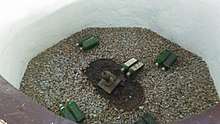Okomfo Anokye
| Okomfo Anokye | |
|---|---|
 | |
| Priest(Okomfo) of the Ashanti Empire |
Okomfo Anokye(also known as Kwame Agyei, Kotowbere, or Tsala), was a traditional priest in the Asante Empire. He's known for his participation in the expansion of the Asante Empire and his many miracles.
Origins
There are multiple accounts regarding Okomfo Anokye's origins.
According to Akuapem tradition, he was son of "Ano" and "Manubea", both from Awukugua in the Nifa Division of the Okere state.[1] His name would originate from an incident :
It is said that when Okomfo Anokye was born in Awukugua he was already holding in his right hand a short white tail of a cow (bodua); and he had so firmly clenched the fist of the other hand that no one could open it. The woman who went to deliver the labouring mother tried to open it because she suspected there was something in it. The father was called in to assist, and immediately the fater came in and touched the hand Okomfo Anokye opened his eyes and, staring at the father, quickly opened the mysterious hand, showing it to the father and saying "Ano....Kye" (Guan language) meaning "Ano...see" and gave to the father what was in it. It is alleged that it was a talisman. From this incident Kwame Agyei got his name "Anokye".
— Amos Anti, "Akwamu, Denkyira, Akuapem, and Ashanti in the Lives of Osei Tutu and Okomfo Anokye" (1971)
This claim was apparently latter confirmed by Otumfuo Nana Osei Tutu II during his visit at Awukugua in 2014.[2]
According to Asante traditions, he was the grandson of a man called "Amoa Gyata" from Bona-Bom, Adanse. There are also claims that he was the son of "Kyei Birie" and "Dwirawira Kwa", who was an Asenie woman from Adanse-Akrokyere.[1]
According to Anlo-Ewe traditions, Okomfo Anokye was from Notsie. His original name was "Tsala", and he was the twin brother of "Tsali". His name would thus originate from an Asante corruption of "Notsie" i.e "Okomfo of Notsie".[3]
According to Nzema traditions, he was from Benyin.[4]
The founding of Ashanti
When Osei Tutu succeeded in about 1690 to the leadership of the small group of Akan forest states around the city of Kumasi, which were already grouped in a loose military alliance, Anokye was his adviser and chief priest. Tutu and Anokye, who must be considered together, carried out the expansionist policy of their predecessors, defeating two powerful enemies, the Akan Doma to the northwest and the Denkyera empire to the south.
It was and still is said by the historians of Ashanti that the Asante people are descendants of the great Ghana Empire(thus the current name that Kwame Nkrumah gave the country), which is said to supplant their martial valour. The Ashanti conquered large parts of Ghana during the 17th century by overthrowing their powerful overlords, the Denkyira. Okomfo Anokye was essentially a powerful cleric who served to rally the people to the cause of his friend the king. Anokye is also said to have placed a dagger in the middle of the Ashanti region, which the Europeans have not been able to take out with any type of technology for over 500 years. Ashanti was one of the few regions in West Africa to achieve victories against the British in battle.
The unification of the Ashanti peoples
To throw off the Denkyira yoke required a powerful unity that transcended the particularism of the Ashanti segments, and Anokye employed not only the political influence of his priesthood but also the spiritual ties it engendered to transform the loose Ashanti alliance into a "national" union in 1695.
Anokye and Tutu established rituals and customs of the Ashanti state to diminish the influence of local traditions. They designated Kumasi, the Ashanti capital. They then established a state council of the chiefs of the preexisting states admitted to the union and suppressed all competing traditions of origin. Finally, they reorganized the Ashanti army.
The war with the Denkyera
The war with Denkyera (1699–1701) went badly at first, but when the Denkyera army reached the gates of Kumasi, Anokye's incantations supposedly produced defections among their generals. The Ashanti broke the Denkyera hegemony and captured the Dutch deed of rent for Elmina Castle. This gave the traders of the empire access to the African coast and involved them henceforth in the commerce and politics of the coastal slave trade. After Osei Tutu's death in 1717, Anokye is said to have returned to Akwapim and died there. The real cause of his death is not known and it is said that he was going to bring the key to death - and so no one should cry; if anyone is heard crying he will never return. After a couple of days he still was not back and so the women cried, and it was said that he did not return again.
References
- 1 2 A. A. Anti (1971). Akwamu, Denkyira, Akuapem, and Ashanti in the Lives of Osei Tutu and Okomfo Anokye. Ghana Publishing Corporation. pp. 8–10.
- ↑ ""Otumfuo Osei Tutu Traces Asantemans Historical Link With Okomfo Anokye"". Retrieved September 4, 2018.
- ↑ Agbotadua Kumassah (2005). The Migration Saga of the Anlo-Ewes of Ghana. Photo-City Press. pp. 43–45.
- ↑ Kwasi Anokye (2 February 2016). Reigns of Trance: A Komfo Anokye Story. Lulu.com. pp. 31–. ISBN 978-1-329-84963-1.
External links
- "The Great Prophet Okomfo Anokye", GhanaWeb, 31 October 2005.
- https://web.archive.org/web/20070820093438/http://www.info-ghana.com/ashanti_empire.htm
- "Asantes Of Ghana History". Asanteman Council Of North America ACONA -USA Canada
- http://www.doth.com/kwanzaa/africa/ghana/ghana.htm
- http://www.cosw.sc.edu/photogallery/ghana2001/pages/Okomfo%20Anokye%2023.htm
- "Osei Tutu (d. 1717)". Black History Pages.